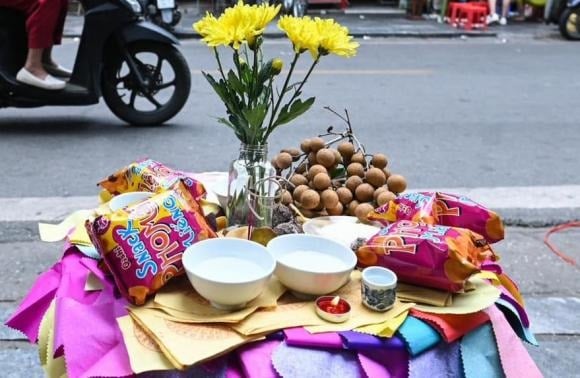Offering ancestral worship is an integral part of Vietnamese culture, passed down from generation to generation. On the altar, rice and salt are two essential offerings. But when is the appropriate time to place rice and salt on the altar, and what is the significance of this practice?
When to Offer Rice and Salt?
Rice, considered a “heavenly gem,” has always been a staple in Vietnamese ceremonial offerings, symbolizing abundance and prosperity. Salt, derived from the essence of the ocean, is a precious natural resource. In Feng Shui, offering rice and salt during ceremonies is believed to attract health, luck, and wealth while dispelling negative energies.
According to Feng Shui expert Ha Thanh, in the context of Vietnam’s rice-farming civilization, rice and salt are essential to daily life, providing nourishment and playing a significant role in ancestral worship rituals. Along with clean water and votive paper, rice and salt are indispensable on the altar, signifying reverence for ancestors and upholding the virtue of “remembering the source of water,” a profound moral value passed down through generations.

Feng Shui expert Ha Thanh emphasizes the vital role of rice and salt in the daily lives of Vietnamese people within their rice-farming civilization.
Offering rice and salt is a way to express gratitude to Buddha, ancestors, and the spiritual realm. In ceremonies like alms-giving and offerings to hungry ghosts, rice and salt are believed to ward off bad luck and negative energies. Folk beliefs hold that rice and salt can dispel malevolent spirits and reverse misfortune, guiding the hungry ghosts back to the underworld without causing trouble in the living world.
Additionally, offering rice and salt demonstrates gratitude to ancestors who established the rice-farming civilization, bringing abundance to their descendants. Offering rice and salt to hungry ghosts is also done with the hope that these lost souls will find sustenance and peace.
Typically, families offer rice and salt during ceremonies on the 15th day of the 7th lunar month, during New Year celebrations, or when performing a housewarming ceremony.
Ratio of Rice to Salt in Offerings
When offering rice and salt, it’s essential to be mindful and meticulous. While some suggest a 3:1 ratio (three parts rice to one part salt) due to rice being the primary staple, many experts believe that an exact ratio is not crucial. What matters most is sincerity, and a rough estimation is sufficient.
The rice and salt used for offerings must be of good quality, new, and clean. Opt for refined white rice and salt, ensuring they are pristine and have not been used before.

The Significance of Offering Rice and Salt on the Ancestral Altar
In Vietnamese spiritual culture, the deceased, such as parents, grandparents, and ancestors, are believed to continue their existence in the “afterlife.” Out of respect and gratitude, descendants offer clean water, rice, and salt as ceremonial gifts. Rice and salt can also be placed on the altar year-round in small jars, symbolizing abundance and hopes for a prosperous new year.
The jars containing rice and salt should be made of fine porcelain with auspicious patterns and exclusively used for worship purposes. During ceremonies, rice and salt are presented directly on the offering tray, typically in bowls or plates of moderate size to maintain aesthetics and balance.
Spreading Rice and Salt After the Ceremony
After the ceremony, the host family has the option to reuse the rice and salt or spread them in the yard, depending on family customs and local traditions. In some places, rice and salt are spread separately, while in others, they are mixed and sprinkled around the altar area. The order of spreading rice and salt varies according to beliefs and customs, but many prefer to spread rice first, followed by salt, to avoid causing inconvenience to hungry ghosts.
Rice and salt are usually spread in the garden or yard, away from high-traffic areas, to create a peaceful space for the hungry ghosts. During this process, the host family may chant “Nam Mo A Di Da Phat” to invite hungry ghosts to receive the offerings and depart peacefully, bringing good fortune and prosperity to the family.
“3 Types of Parenting Styles That May Lead to Unfilial Children: A Warning for Families”
Many parents complain that their children do not reciprocate their love, and it is often due to a smothering form of affection. This overbearing approach can be counterproductive, pushing children away instead of fostering a healthy, loving relationship. It is essential for parents to understand that while their love for their children may be overwhelming, it must be expressed in a manner that allows their children to thrive and develop their own sense of self. A delicate balance must be struck between providing unconditional love and giving children the space to grow and explore their independence.






































